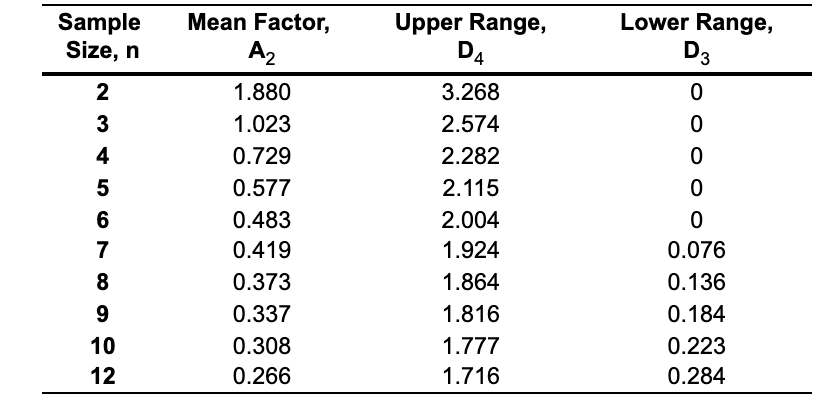Refer to Table S6.1 - Factors for Computing Control Chart Limits (3 sigma) for this problem. Eagletrons are all-electric automobiles produced by Mogul Motors, Inc. One of the concerns of Mogul Motors is that the Eagletrons be capable of achieving appropriate maximum speeds. To monitor this, Mogul executives take samples of six Eagletrons at a time. For each sample, they determine the average maximum speed and the range of the maximum speeds within the sample. They repeat this with 35 samples to obtain 35 sample means and 35 ranges. They find that the average sample mean is 93.50 miles per hour, and the average range is 3.00 miles per hour. Using these results, the executives decide to establish an R-chart. They would like this chart to be established so that when it shows that the range of a sample is not within the control limits, there is only approximately a 0.0027 probability that this is due to natural variation. The control limits for the chart based on the above requirement for the given information are: UCLE = 6.012 miles per hour (round the reponse to three decimal places). LCL, =miles per hour (round the reponse to three decimal places).
Refer to Table S6.1 - Factors for Computing Control Chart Limits (3 sigma) for this problem. Eagletrons are all-electric automobiles produced by Mogul Motors, Inc. One of the concerns of Mogul Motors is that the Eagletrons be capable of achieving appropriate maximum speeds. To monitor this, Mogul executives take samples of six Eagletrons at a time. For each sample, they determine the average maximum speed and the range of the maximum speeds within the sample. They repeat this with 35 samples to obtain 35 sample means and 35 ranges. They find that the average sample mean is 93.50 miles per hour, and the average range is 3.00 miles per hour. Using these results, the executives decide to establish an R-chart. They would like this chart to be established so that when it shows that the range of a sample is not within the control limits, there is only approximately a 0.0027 probability that this is due to natural variation. The control limits for the chart based on the above requirement for the given information are: UCLE = 6.012 miles per hour (round the reponse to three decimal places). LCL, =miles per hour (round the reponse to three decimal places).
Practical Management Science
6th Edition
ISBN:9781337406659
Author:WINSTON, Wayne L.
Publisher:WINSTON, Wayne L.
Chapter4: Linear Programming Models
Section: Chapter Questions
Problem 91P
Related questions
Question
100%
hw3q5

Transcribed Image Text:Refer to Table S6.1 - Factors for Computing Control Chart Limits (3 sigma) for this problem.
Eagletrons are all-electric automobiles produced by Mogul Motors, Inc. One of the concerns of Mogul Motors is that the Eagletrons be capable of achieving appropriate maximum speeds. To monitor this, Mogul executives take samples of six
Eagletrons at a time.
For each sample, they determine the average maximum speed and the range of the maximum speeds within the sample.
They repeat this with 35 samples to obtain 35 sample means and 35 ranges. They find that the average sample mean is 93.50 miles per hour, and the average range is 3.00 miles per hour. Using these results, the executives decide to
establish an R-chart. They would like this chart to be established so that when it shows that the range of a sample is not within the control limits, there is only approximately a 0.0027 probability that this is due to natural variation.
The control limits for the chart based on the above requirement for the given information are:
UCL, = 6.012 miles per hour (round the reponse to three decimal places).
LCLR =
miles per hour (round the reponse to three decimal places).

Transcribed Image Text:Mean Factor,
Lower Range,
Sample
Size, n
Upper Range,
D4
A2
D3
2
1.880
3.268
1.023
2.574
4
0.729
2.282
0.577
2.115
6
0.483
2.004
7
0.419
1.924
0.076
8
0.373
1.864
0.136
9.
0.337
1.816
0.184
10
0.308
1.777
0.223
12
0.266
1.716
0.284
Expert Solution
This question has been solved!
Explore an expertly crafted, step-by-step solution for a thorough understanding of key concepts.
This is a popular solution!
Trending now
This is a popular solution!
Step by step
Solved in 2 steps with 2 images

Recommended textbooks for you

Practical Management Science
Operations Management
ISBN:
9781337406659
Author:
WINSTON, Wayne L.
Publisher:
Cengage,

Practical Management Science
Operations Management
ISBN:
9781337406659
Author:
WINSTON, Wayne L.
Publisher:
Cengage,